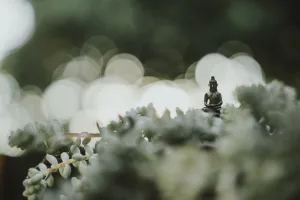Step into the enchanting world of Japanese gardens and be captivated by the allure of red bridges. These vibrant structures, seemingly suspended over tranquil ponds or gracefully spanning carefully arranged rocks, hold a deeper significance than meets the eye. As you explore the intricate design and cultural symbolism behind these red bridges, you will uncover a story that intertwines nature, spirituality, and aesthetics, immersing you in the profound beauty of Japanese garden traditions.
Understanding Japanese Gardens
Japanese gardens are renowned for their exquisite beauty and meticulous design. These gardens are not just spaces for aesthetic pleasure; they are a reflection of the deep cultural and spiritual traditions of Japan. To truly understand Japanese gardens, it is essential to explore their origins, design principles, and the common elements and symbols that make them unique.
Origins of Japanese Gardens
The origins of Japanese gardens can be traced back to the Asuka period (592-710) when Japan started to adopt cultural elements from China and Korea. However, it was during the Heian period (794-1185) that the concept of the Japanese garden truly flourished. The gardens during this period were heavily influenced by Buddhist and Taoist philosophies, which emphasized the harmony between man and nature.
Design Principles of Japanese Gardens
Japanese gardens follow a set of principles that contribute to their serene and harmonious atmosphere. These design principles include asymmetry, balance, simplicity, and the use of natural materials. Each element in a Japanese garden is meticulously chosen and arranged to create a sense of tranquility and balance. The careful placement of rocks, water features, and vegetation reflects the belief in the interconnectedness of all things in nature.
Common Elements and Symbols in Japanese Gardens
Japanese gardens are known for their distinctive features and symbolic elements. Some of the common elements include water features such as ponds and streams, meticulously pruned trees and shrubs, stone lanterns, and decorative bridges. These elements hold symbolic meanings and represent the balance and harmony found in nature. The use of symbolic elements creates a sense of tranquility and invites contemplation in Japanese gardens.
The Role and Significance of Bridges in Japanese Gardens
Bridges play a significant role in Japanese gardens and are one of the most recognizable features of these landscapes. They not only serve a practical purpose of crossing over water, but they also hold deep cultural and symbolic meanings.
Historical Use of Bridges
Bridges have been an integral part of Japanese gardens for centuries. They were originally introduced from China and adapted to fit the Japanese garden aesthetic. In the past, bridges were primarily functional structures that facilitated movement within the garden and allowed the visitors to explore various areas. They were also used as viewing platforms to appreciate the overall beauty of the garden.
Symbolic Meaning of Bridges
bridges in Japanese gardens symbolize the transition between different worlds or states of being. They represent the connection between the physical and spiritual realms. Crossing a bridge is seen as a metaphorical journey, a passage from one state of mind or existence to another. The act of crossing a bridge is associated with leaving behind the mundane world and entering into a more refined and contemplative state.
Varieties of Bridges in Japanese Gardens
Japanese gardens feature a wide variety of bridge designs, each with its own unique characteristics and symbolism. The most common types of bridges include arched bridges (taikobashi), flat bridges (hirabashi), and zigzag bridges (yatsuhashi). Arched bridges are elegant and offer a graceful passage over water, while flat bridges provide a more direct and straightforward approach. Zigzag bridges, on the other hand, create a sense of meandering and add a dynamic element to the garden.

Introduction to Red Bridges
While bridges in Japanese gardens come in various shapes and forms, the red bridge holds a special place in Japanese culture. It has a rich history and profound cultural and spiritual significance.
The Ancient Tradition of Red Bridges
The tradition of red bridges in Japanese gardens dates back to ancient times. The use of red pigment was influenced by Chinese culture and was believed to ward off evil spirits. Red was also associated with power, energy, and vitality. Over time, the tradition of painting bridges red became deeply ingrained in Japanese garden design.
Cultural and Spiritual Significance
The red bridge holds great cultural and spiritual significance in Japanese gardens. It is seen as a symbol of protection, guiding visitors across the water and towards a sacred space. Red is also associated with good luck and good fortune in Japanese culture. The vibrant color is believed to attract positive energy and ward off negative influences.
Associations with Shinto and Buddhism
The red bridge is closely associated with both Shintoism and Buddhism, the two major religious traditions in Japan. In Shintoism, red is considered a sacred color and is often used to mark holy or significant places. The red bridge serves as a gateway to the spiritual realm, connecting the earthly world with the realm of the gods and ancestors. In Buddhism, the color red symbolizes enlightenment, passion, and transformation.
Aesthetic and Architectural Features of Red Bridges in Japanese Gardens
Red bridges not only hold cultural and spiritual significance, but they also possess unique aesthetic and architectural features that contribute to the overall beauty of Japanese gardens.
Architectural Style and Design
Red bridges in Japanese gardens typically follow traditional architectural styles and designs. They often feature a curved or arched shape, resembling the elegant and graceful lines found in classic Japanese architecture. The bridges are meticulously constructed to blend harmoniously with the surrounding landscape, creating a seamless integration between the natural and man-made elements.
Materials Used for Construction
The materials used for constructing red bridges vary depending on the design and scale of the garden. Traditional Japanese gardens often use natural materials such as wood, stone, and earth. The bridge beams are usually made from sturdy Japanese cypress or pine wood, while the railings and supports are crafted with precision and attention to detail. The red color is achieved through the use of traditional red lacquer or paint, which not only adds color but also protects the bridge from weathering.
The Artistic Semiotics of Red Bridges
In addition to their architectural features, red bridges in Japanese gardens possess artistic semiotics that contribute to their overall visual impact. The vibrant red color stands out against the lush greenery and reflects light, creating a striking contrast and attracting the attention of visitors. The red bridge becomes a focal point in the garden, drawing the eye and leading the viewer on a visual journey through the landscape.

Symbolism of the Color Red in Japanese Culture
To fully appreciate the symbolism of red bridges in Japanese gardens, it is important to understand the cultural significance of the color red in Japanese culture.
Traditional Significance of Red
In Japanese culture, red has long been associated with power, passion, and vitality. It is a color that represents energy, life force, and courage. Red is also considered a lucky color and is often used in celebrations and festive occasions. In traditional Japanese weddings, the bride wears a red kimono, symbolizing happiness, good fortune, and the beginning of a new chapter in life.
Implications in Modern Japan
While the traditional meanings of red still hold importance in modern Japan, the symbolism of the color has expanded to include other connotations. Red is often associated with strong emotions such as love and desire, as well as with modern concepts such as power, success, and ambition. The color red has become a powerful symbol in advertising and branding, evoking a sense of energy and excitement.
Understanding the Dichotomy: Sacred and Profane
The symbolism of the color red in Japanese culture is not limited to one specific interpretation. It encompasses a dichotomy between the sacred and the profane. On one hand, red is associated with the divine, spiritual, and sacred aspects of life. On the other hand, red is also connected to earthly desires, sensuality, and the transient nature of human existence. This duality of meanings adds depth and complexity to the symbolism of red bridges in Japanese gardens.
The Red Bridge as a Transition
The red bridge serves as a metaphorical and physical transition within Japanese gardens. It embodies the concept of change, impermanence, and the continuous flow of life.
Bridges as Thresholds
Bridges, in general, represent a threshold or a passage from one place to another. They create a sense of anticipation and invite exploration. In Japanese gardens, the red bridge acts as a threshold for visitors, signaling a transition from the ordinary world to a more sacred and contemplative space. Crossing the bridge becomes a metaphorical journey, a way to leave behind the mundane and enter into a realm of tranquility and reflection.
The Philosophical Interpretation of Transition
The concept of transition is deeply rooted in Japanese philosophy and aesthetics. In Japanese gardens, the red bridge symbolizes the transitory nature of life and the acceptance of impermanence. It reminds us that everything is in a constant state of change and that we must embrace this fluidity rather than resist it. The bridge encourages reflection and contemplation on the ephemerality of existence.
The Concept of Change and Impermanence
Change and impermanence are fundamental principles in Japanese culture and are closely related to the concept of wabi-sabi. Wabi-sabi embraces the beauty of imperfection and impermanence, recognizing the value of transience and the natural cycles of life. The red bridge serves as a reminder that everything is fleeting and that we should cherish the present moment. It encourages us to let go of attachments and to appreciate the beauty in the ephemeral.

Influence of Zen Buddhism on the Red Bridges
Zen Buddhism has had a profound influence on Japanese garden design, including the use of red bridges. Zen principles encourage simplicity, mindfulness, and the pursuit of enlightenment.
Zen Principles in Garden Design
Zen gardens are known for their minimalist design, creating a sense of calmness and serenity. This simplicity is reflected in the design of red bridges in Japanese gardens. The bridges are typically unadorned, with clean lines and minimal embellishment. This simplicity allows for a deeper connection with the natural environment and invites contemplation and meditation.
The Experience of ‘Satori’ or Enlightenment
The ultimate goal of Zen practice is to attain enlightenment or ‘satori.’ Zen practitioners strive to reach a state of heightened awareness and spiritual awakening. The red bridge serves as a physical and metaphorical pathway to this enlightenment. Crossing the bridge becomes a symbolic journey towards self-discovery and a deeper understanding of one’s place in the universe.
Incorporation of Zen Aesthetics and Philosophy
Zen aesthetics and philosophy are deeply intertwined with Japanese garden design. The red bridges in Japanese gardens embody the principles of simplicity, harmony, and mindfulness found in Zen Buddhism. They serve as a visual representation of the Zen ideal of non-duality, the merging of the self with the natural world. The red bridge becomes a focal point for meditation, drawing the viewer’s attention to the present moment and facilitating a deeper connection with the surroundings.
Red Bridges in Tea Gardens
Tea gardens, or chaniwa, hold a special place in Japanese culture and are known for their tranquil atmosphere. Red bridges play a significant role in enhancing the tea garden experience.
Special Role of Red Bridges in Tea Ceremony
The tea ceremony is a highly ritualized and meditative practice that embodies the principles of harmony, respect, and tranquility. Red bridges within tea gardens serve as a transition from the outer world to the inner sanctum of the tea house. Crossing the bridge signifies leaving behind the distractions of the outside world and entering into a space of serenity and mindfulness.
Symbolizing the Journey of the Tea Master
The journey across the red bridge symbolizes the inner journey of the tea master. It represents the transition from the mundane to the sacred and the transformation that takes place within. The tea master must navigate the bridge with grace and humility, reflecting their dedication to the art of tea and their commitment to the principles of Zen and harmony.
Integration with Other Tea Garden Elements
Red bridges in tea gardens are carefully integrated with other elements to create a harmonious and contemplative space. The bridge’s placement is deliberately chosen to interact with the surrounding landscape, water features, and tea house. The sound of water flowing beneath the bridge adds a soothing element to the tea garden experience, enhancing the overall sense of tranquility and mindfulness.
Famous Japanese Gardens with Red Bridges
Japan is home to many iconic gardens that feature stunning red bridges. These gardens are not only a testament to the craftsmanship and artistic sensibility of the Japanese people but also provide a glimpse into the rich cultural and spiritual traditions of the country.
Iconic Red Bridges in Japan
One of the most famous red bridges in Japan can be found in the garden of Katsura Imperial Villa in Kyoto. This bridge, known as Togetsukyo or “Moon Crossing Bridge,” is a masterpiece of simplicity and elegance. The garden of Rikugien in Tokyo also features a renowned red bridge, adding a vibrant splash of color to the meticulously landscaped surroundings.
Visiting and Interpreting These Gardens
Visiting these gardens offers a unique opportunity to immerse oneself in the beauty and tranquility of Japanese garden design. The red bridges serve as focal points for contemplation and reflection, inviting visitors to connect with nature and experience a sense of inner peace. It is important to approach these gardens with an open mind and a willingness to appreciate the subtleties and symbolism of the red bridges and other elements within the landscape.
Examples of Red Bridges Outside of Japan
The influence of Japanese garden design can be seen in various parts of the world. Red bridges have become a popular feature in many international gardens inspired by Japanese aesthetics. The Portland Japanese Garden in Oregon, USA, features a red arched bridge that harmoniously blends with the surrounding foliage. Similarly, the Butchart Gardens in British Columbia, Canada, incorporates a red bridge into their Japanese Garden, creating a serene and contemplative space.
Creating Your Own Japanese Garden with a Red Bridge
Creating a Japanese garden in your own backyard can be a rewarding and meditative experience. Incorporating a red bridge into your design adds a touch of authenticity and symbolism, elevating the overall aesthetic and spiritual quality of your garden.
Conceptualizing the Overall Design
When creating a Japanese garden, it is important to consider the principles of balance, simplicity, and harmony. Start by visualizing the overall layout and flow of the garden. Determine the size and placement of the bridge to ensure it complements the rest of the design. A red bridge can serve as a focal point or a transition between different areas of the garden.
Choosing the Right Bridge
Selecting the right bridge is crucial to achieving the desired aesthetic and symbolic effect. Consider the size and style of the bridge to ensure it harmonizes with the surrounding landscape. The bridge should be made from high-quality materials that will withstand weather conditions and age gracefully over time. It is also important to maintain the bridge regularly to ensure its longevity and preserve its vibrant red color.
Additional Elements to Complement the Red Bridge
To complete your Japanese garden, consider adding additional elements that complement the red bridge and enhance the overall atmosphere. Incorporate water features such as ponds or streams, stone lanterns, moss-covered boulders, and meticulously pruned trees and shrubs. Each element should be carefully chosen and arranged to create a sense of tranquility, harmony, and authenticity.
In conclusion, red bridges in Japanese gardens hold deep cultural, spiritual, and aesthetic significance. They symbolize transition, change, and the interconnection between the physical and spiritual realms. Whether visiting iconic Japanese gardens or creating your own, the red bridge serves as a focal point for contemplation, inviting us to appreciate the beauty of impermanence and the presence of the present moment.




